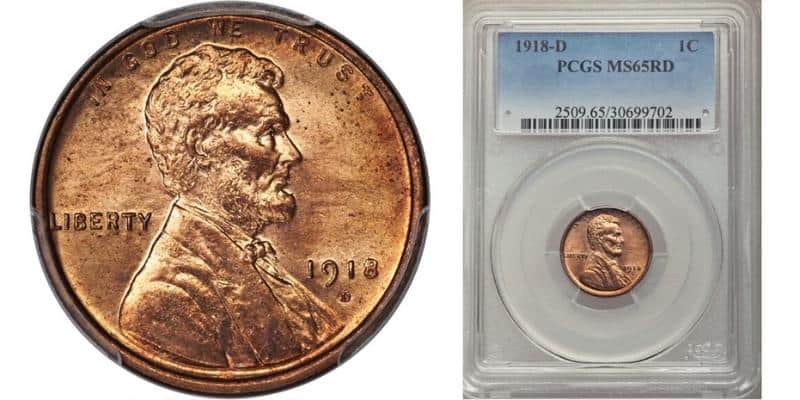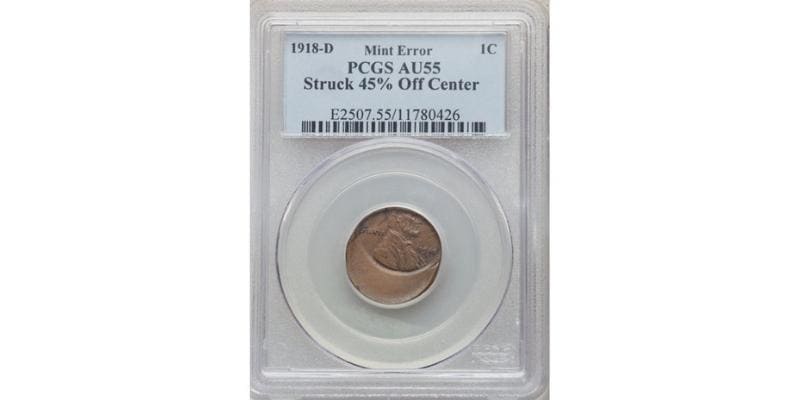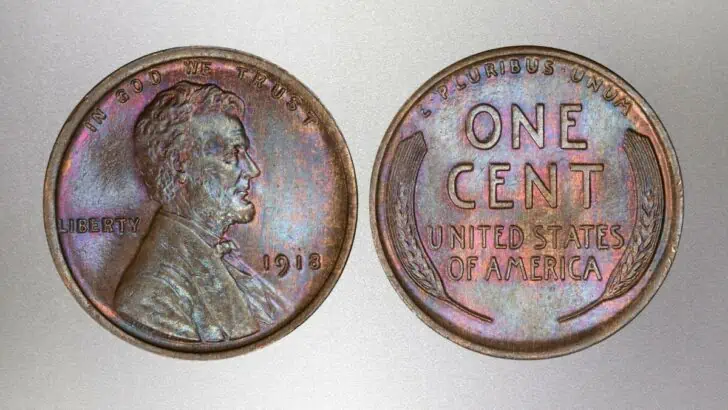History and Production of the 1918 Lincoln Wheat Penny
In 1918, the United States was fully involved in World War I. Songwriter Irving Berlin, drafted into the Army, wrote “Oh, How I Hate To Get Up In The Morning!” for the revue “Yip, Yip, Yaphank!” featuring a chorus of Army recruits. After the final performance of the show, in September 1918, the entire chorus, Berlin included, marched off through the streets of New York, bound for a troop transport that took the unit to France.
During the war, industrial wages more than doubled, from an average of just under .23 in 1914 to nearly .48 by 1919. Such inflation meant that a penny might not buy much, and it took three of them, during the war, to buy a postage stamp. The U.S. Mints continued turning out coins of all sorts, including bronze one cent coins, the Lincoln Wheat Penny. The Philadelphia Mint, as usual for this period, contributed far and away the vast majority of Lincoln one cent pieces, with the Denver Mint following a distant second, and the San Francisco Mint following an even more distant third.
| Mint | Coins Struck |
| 1918 | 288,104,634 |
| 1918-D | 47,830,000 |
| 1918-S | 34,680,000 |
| Total | 370,614,634 |
How Much is a 1918 Lincoln Penny Worth?
| 1918 Penny Value Chart | ||||
| Type | Grade | |||
| Good G4 | Uncirculated MS63 | Uncirculated MS65 | Uncirculated MS67 | |
| 1918 1C BN | $0.30 | $21.60 | $228.00 | — |
| 1918 1C RB | — | $27.00 | $260.00 | — |
| 1918 1C RD | — | $108.00 | $520.00 | $2,750.00 |
| 1918-D 1C BN | $0.75 | $143.00 | $488.00 | — |
| 1918-D 1C RB | — | $195.00 | $1,020.00 | — |
| 1918-D 1C RD | — | $429.00 | $4,000.00 | $60,000.00 |
| 1918-S 1C BN | $0.40 | $195.00 | $715.00 | — |
| 1918-S 1C RB | — | $260.00 | $1,250.00 | — |
| 1918-S 1C RD | — | $618.00 | $4,380.00 | — |
The 1918 penny value, like the value of any coin, depends upon its rarity and its condition, also called its grade. Coins with many specimens struck will remain more plentiful than coins with fewer specimens struck. Fewer coins increase the rarity, and makes a coin more valuable. Coins which exhibit less surface wear, oxidation, and corrosion are more desirable to collectors, and so also more valuable.
All three mints coined a great many Lincoln wheat pennies in 1918. At the very lowest grades, of good and fine, the coins remain within easy and affordable reach of collectors. After that, however, prices begin to rise steeply; 1918 Lincoln wheat pennies received heavy use and high grade coins are scarce. Since the Philadelphia mint struck many times more wheat pennies than both the Denver and San Francisco mints combined, more Philadelphia coins are available to collectors and prices at all ordinary grades are lower. Denver and San Francisco Lincoln pennies cost at least two or three times the same graded Philadelphia penny for 1918 specimens.
Uncirculated, or mint-state Lincoln wheat pennies from 1918 are somewhat rare, regardless of the mint in question. While the lower rated MS coins, of MS-63 or 65 can sometimes be found at auction, higher rated specimens, like MS-66 are much less common, and coins rated at MS-67 or better are seldom found for sale at auction. They command accordingly high prices.

In June, 2021, a 1918-D MS-65 RD Lincoln wheat penny sold at Heritage Auction for $2,640. The coin had a very nice copper color, and only one major nick or mark near Lincoln’s mouth. A similar example, of a 1918-D MS-65 RD, sold in April 2019, fetched $2,400 at Heritage Auctions. This shows some price appreciation over two years, of approximately 10%. While this sort of appreciation may seem gratifying to collectors, and tempting to investors and speculators, prices can just as easily go the other direction, depending on a variety of circumstances.
The difference in value between grades can be seen in the results of a previous sale, held in January 2019. Again, a 1918-D was up for auction, but the grade was MS-67. The Heritage Auction catalog describes the coin as unique, the sole known example recorded by the grading services. The coin was further described as having a good, detailed strike; the dies used were not worn, as they were for many Lincoln coins produced. This increased the value, and the coin sold for $45,600.00 at auction.
Also in January 2019, a 1918-D MS-66 RD sold for $18,000 at the same auction. The coin in question is described as having an uncommonly sharp strike, which is unusual for Lincoln wheat cent strikes, not only in 1918, but in the early years of the century generally for pennies. All three branches of the Mint tended to use dies excessively, and wear them out rather than replace them. As the dies degraded, the coins struck from them became progressively less crisp, and more “fuzzy” in their appearance. This affects the grade of the coin, especially at the uncirculated or mint-state level.
The 1918-D MS-67 RD coin actually has a track record at auction, being a unique specimen, having sold in 2016. In that year, Heritage Auction managed to sell the coin for $42,300. The coin thus appreciated by about $3,000 over three years.
A 1918 MS-67+ RD Lincoln wheat penny sold in November 2014 at Heritage Auction. As the catalog pointed out, 1918 Lincoln wheat pennies graded at MS-67 or above are extremely rare. The catalog estimated that no more than 1200 high grade coins existed. Only two such were rated at MS-67+ and only one at MS-68. The coin sold for $17,625.
In 2015, a 1918 MS-67 RD Lincoln one cent coin sold for $6,462.50 through Heritage Auctions. This particular coin had been graded and certified by CAC, one of the professional grading services, and so came with a certificate. Lincoln wheat pennies from 1918 with CAC certification are especially rare, and only 11 such examples were listed by CAC in 2015.
A similar coin, a 1918 MS-67 RD, sold in 2016, actually fetched far less at auction, yielding a sale price of only $3,760.00. The pool of bidders for unique or highly rare coins is sometimes quite limited, and sales prices can be reflective, not of the scarcity of the coin, or of its appearance, but of the scarcity of bidders and their non-appearance at a given auction. One cannot always say that coins will fetch consistently higher and higher values at successive auctions, or always increase in value over the short term.
The same cautionary note, that successive auctions don’t always result in higher values, and can be idiosyncratic at the higher end of any collectible, can be found by looking at a specific 1918-S MS-65 RD. The coin in question has a known provenance that can be traced through the sales catalogs of Heritage Auctions. It came from the J. and A. Walsh collection, and was identified as such the first time it sold in 2006. In that year, this particular coin, described as having a “tawny coppery-gold color,” realized $21,850.00. In December, 2008, the coin, with the same description and provenance, sold again. In the second auction, it realized only $11,500.00. The financial crisis of 2007-2008 was in full swing, at that time, and so bidders may have been scarce. But, whatever the reason, a loss of nearly 50% must have been unwelcome news to the owner.
San Francisco uncirculated coins are similarly uncommon, and higher grades, of MS-67 or better, rarely appear at auction, if at all. In 2010, a 1918-S MS-65 RD sold at auction for $9,200. The auction house noted that pure red examples of 1918 Lincoln uncirculated pennies were quite rare, and that more commonly, oxidation had left the coins either brown, or red-brown, which precludes the specimens from having the very highest grades. Even in the case of this particular coin, some light brown spots appeared, though not enough to reduce the grade of the coin.
Were any 1918 Proof Lincoln Wheat Pennies Produced?
The U.S. Mint ceased production of all proof coins two years earlier, in 1916, claiming that interest on the part of collectors was limited. Certainly, in the years preceding 1916, proof mintage numbered only in the thousands of coins. Proof coin production was not resumed until 1936. Thus, there are no genuine 1918 proof Lincoln wheat pennies.
Are there any 1918 penny error values?
Despite the best efforts at quality control, given the number of one cent pieces produced in 1918, errors and mis-strikes were bound to creep out of the Mint, and reach general circulation. Also, in the early part of the twentieth century, all three mints developed the habit of using coin dies far longer than intended. Weak strikes were common, and dies could crack, with coins reaching circulation.
In the case of die cracks, any penny struck with a cracked die will show evidence of the defect. These can be somewhat common at lower grades, and value may not be significant. Thus, in 2000, Heritage Auctions sold a multiple coin lot, including a 1918 F-12 Lincoln cent with a die crack running across the entire face of the coin. The lot fetched only $69.00 at sale.
In contrast, Lincoln penny collectors often times look for errors wherever they can be found, and collect them. These defective coins can sometimes be quite valuable. A few erors for 1918 are known, and sometimes appear at auction.

For example, in 2019, Heritage Auction sold a 1918-D AU-55 Wheat Penny that was struck off center, with only 45% of the image showing. Off center coin errors arise when a coin doesn’t enter the stamping mill properly, and isn’t held by the retaining collar. Besides usual considerations of grade, such coins become more valuable if the date and mint mark show. In this case, the coin realized $336 at auction. In contrast, an ordinary AU-55 1918 specimen from the Denver Mint would be valued at something less than $50.00.
In 2008, Heritage Auctions offered a very unusual 1918-D Lincoln wheat cent error. Occasionally, a coin will be held in the press, and accidentally struck a second time, shifting slightly. Such a coin, with two images, is called a “double strike” error. Rarely, a coin will flip over, so that the second strike will be against the other die and both images will appear. This is called a “flip-over double strike.”
The coin in question, a 1918-D XF-40 flip over double strike, realized $431.25 in the bidding. In contrast, a correctly struck 1918-D wheat penny, of the same grade can be found for less than $20, according to the value guide.
Technical Specifications of the 1918 Lincoln Penny
By 1918, the Lincoln wheat penny had already seen nine years in production, and was a well-established and popular design. The original design in 1909 by Victor D. Brenner featured his initials on the reverse of the coin. The Treasury Department and the Mint removed the initials, though not before many pennies were struck. Lincoln wheat pennies had no initials for the designer for several years, until 1918, when the mark VDB was placed just below the bust of Lincoln, near the rim.
Like all other Lincoln wheat pennies, the 1918 one cent piece weighed 3.11 grams, and had a diameter of 19 millimeters. It contained a plain edge, similar to the nickel. Although the one cent piece looks to be made of pure copper, it is actually a bronze coin, made from 95% copper and 5% zinc and tin.
Summary
The U.S. Mints, in 1918, produced what was then considered a very large number of Lincoln wheat pennies, in excess of 300 million. Demand was no doubt driven, in part, by the exigencies of the war, and the inflation that came with it. Those coins tended to circulate, and many surviving examples are heavily worn. Consequently, 1918 wheat pennies can be found at inexpensive prices in the Good and Fine grades for all three mints. Availability falls off rapidly, and prices rise, as one proceeds through the grading scale. At the high end, of uncirculated coins, with nice red coloration, specimens become vanishingly few, or even unique. Most uncirculated specimens are either lower grade, because of weak strikes, or suffering from some coloration from oxidation. Despite the enormous mintage numbers, uncirculated mint-state coins for the 1918 Lincoln wheat penny can be surprisingly valuable.
